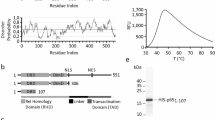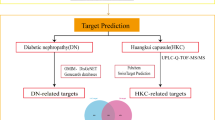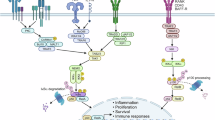Abstract
Aim:
To study the molecular mechanism underlying the effect of aristolochic acid (AA), a major active component of plants from the Aristolochiaceae family using microarray analysis.
Methods:
Human kidney (HK-2) cells were treated with AA (0, 10, 30, and 90 μmol/L) for 24 h, and the cell viability was measured by a 3-(4,5-dimethylthiazol-2yl)-2,5-diphenyltetrazolium bromide assay. Complementary DNA microarrays were used to investigate the gene expression pattern of HK-2 cells exposed to AA in triplicate. A quantitative reverse transcriptase-polymerase chain reaction (qRT-PCR) assay was used to verify the microarray data for selected nuclear factor kappa B (NF-κB)-regulated genes. Furthermore, the subcellular localization of NF-κB p65 was visualized by immunofluorescence confocal microscopy in HK-2 cells. The NF-κB activity was examined by a luciferase reporter assay in HK-2/NF-κB transgenic cells.
Results:
AA exhibited a dose-dependent cytotoxic effect in HK-2 cells and induced alterations in the gene expression profiles related to the DNA damage response, DNA repair, macromolecule metabolic process, carbohydrate metabolic process, DNA metabolic process, apoptosis, cell cycle, and transcription. In addition, 9 biological pathways associated with immunomodulatory functions were down-regulated in AA-treated HK-2 cells. A network analysis revealed that NF-κB played a central role in the network topology. Among NF-κB-regulated genes, 8 differentially expressed genes were verified by qRT-PCR. The inhibition of NF-κB activity by AA was further confirmed by immunofluorescence confocal microscopy and by NF-κB luciferase reporter assay.
Conclusion:
Our data revealed that AA could suppress NF-κB activity in normal human cells, perhaps partially accounting for the reported anti-inflammatory effects of some plants from the genus Aristolochia.
Similar content being viewed by others
Log in or create a free account to read this content
Gain free access to this article, as well as selected content from this journal and more on nature.com
or
References
Rosenmund H, Reichstein T . Zur Kenntnis der Aristolochiasäure. Pharm Acta Helv 1943; 18: 243–61.
Debelle FD, Vanherweghem JL, Nortier JL . Aristolochic acid nephropathy: a worldwide problem. Kidney Int 2008; 74: 158–69.
Zhang G, Shimokawa S, Mochizuki M, Kumamoto T, Nakanishi W, Watanabe T, et al. Chemical constituents of Aristolochia constricta: antispasmodic effects of its constituents in guinea-pig ileum and isolation of a diterpeno-lignan hybrid. J Nat Prod 2008; 71: 1167–72.
Messiano GB, Vieira L, Machado MB, Lopes LM, de Bortoli SA, Zukerman-Schpector J . Evaluation of insecticidal activity of diterpenes and lignans from Aristolochia malmeana against Anticarsia gemmatalis. J Agric Food Chem 2008; 56: 2655–9.
Hinou J, Demetzos C, Harvala C, Roussakis C . Cytotoxic and antimicrobial principles from the roots of Aristolochia longa. Int J Crude Drug Res 1990; 28: 149–51.
Arlt VM, Stiborova M, Schmeiser HH . Aristolochic acid as a probable human cancer hazard in herbal remedies: a review. Mutagenesis 2002; 17: 265–77.
Loiko EN, Samal AB, Shulyakovskaya SM . H2O2-induced platelet aggregation and increase in intracellular Ca2+ concentration are blocked by inhibitors of intracellular signaling. Biochemistry (Mosc) 2003; 68: 1210–6.
Iuliano L, Pedersen JZ, Pratico D, Rotilio G, Violi F . Role of hydroxyl radicals in the activation of human platelets. Eur J Biochem 1994; 221: 695–704.
Marshall LA, Chang JY, Calhoun W, Yu J, Carlson RP . Preliminary studies on phospholipase A2-induced mouse paw edema as a model to evaluate antiinflammatory agents. J Cell Biochem 1989; 40: 147–55.
Vishwanath BS, Fawzy AA, Franson RC . Edema-inducing activity of phospholipase A2 purified from human synovial fluid and inhibition by aristolochic acid. Inflammation 1988; 12: 549–61.
Lindahl M, Tagesson C . Selective inhibition of group II phospholipase A2 by quercetin. Inflammation 1993; 17: 573–82.
Rosenthal MD, Vishwanath BS, Franson RC . Effects of aristolochic acid on phospholipase A2 activity and arachidonate metabolism of human neutrophils. Biochim Biophys Acta 1989; 1001: 1–8.
Moreno JJ . Effect of aristolochic acid on arachidonic acid cascade and in vivo models of inflammation. Immunopharmacology 1993; 26: 1–9.
Shirwaikar A, Somashekar AP, Udupa AL, Udupa SL, Somashekar S . Wound healing studies of Aristolochia bracteolata Lam. with supportive action of antioxidant enzymes. Phytomedicine 2003; 10: 558–62.
Kluthe R, Vogt A, Batsford S . Double blind study of the influence of aristolochic acid on granulocyte phagocytic activity. Arzneimittelforschung 1982; 32: 443–5. German.
Vanherweghem JL, Depierreux M, Tielemans C, Abramowicz D, Dratwa M, Jadoul M, et al. Rapidly progressive interstitial renal fibrosis in young women: association with slimming regimen including Chinese herbs. Lancet 1993; 341: 387–91.
Vanhaelen M, Vanhaelen-Fastre R, But P, Vanherweghem JL . Identification of aristolochic acid in Chinese herbs. Lancet 1994; 343: 174.
Martinez MC, Nortier J, Vereerstraeten P, Vanherweghem JL . Progression rate of Chinese herb nephropathy: impact of Aristolochia fangchi ingested dose. Nephrol Dial Transplant 2002; 17: 408–12.
Cosyns JP, Jadoul M, Squifflet JP, Van Cangh PJ, Van Ypersele de Strihou C . Urothelial malignancy in nephropathy due to Chinese herbs. Lancet 1994; 344: 188.
Nortier JL, Martinez MC, Schmeiser HH, Arlt VM, Bieler CA, Petein M, et al. Urothelial carcinoma associated with the use of a Chinese herb (Aristolochia fangchi). N Engl J Med 2000; 342: 1686–92.
Lai MN, Lai JN, Chen PC, Tseng WL, Chen YY, Hwang JS, et al. Increased risks of chronic kidney disease associated with prescribed Chinese herbal products suspected to contain aristolochic acid. Nephrology 2009; 14: 227–34.
Cheng WY, Hsiang CY, Bau DT, Chen JC, Shen WS, Li CC, et al. Microarray analysis of vanillin-regulated gene expression profile in human hepatocarcinoma cells. Pharmacol Res 2007; 56: 474–82.
Smyth GK, editor. Limma: linear models for microarray data. New York: 2005. p 397–420.
Montaner D, Tarraga J, Huerta-Cepas J, Burguet J, Vaquerizas JM, Conde L, et al. Next station in microarray data analysis: GEPAS. Nucleic Acids Res 2006; 34: W486–91.
Seifert M, Scherf M, Epple A, Werner T . Multievidence microarray mining. Trends Genet 2005; 21: 553–8.
Shannon P, Markiel A, Ozier O, Baliga NS, Wang JT, Ramage D, et al. Cytoscape: a software environment for integrated models of biomolecular interaction networks. Genome Res 2003; 13: 2498–504.
Simoes ML, Hockley SL, Schwerdtle T, da Costa GG, Schmeiser HH, Phillips DH, et al. Gene expression profiles modulated by the human carcinogen aristolochic acid I in human cancer cells and their dependence on TP53. Toxicol Appl Pharmacol 2008; 232: 86–98.
Chen T, Guo L, Zhang L, Shi L, Fang H, Sun Y, et al. Gene expression profiles distinguish the carcinogenic effects of aristolochic acid in target (Kidney) and non-target (Liver) tissues in rats. BMC Bioinformatics 2006; 7: S20.
Stemmer K, Ellinger-Ziegelbauer H, Ahr HJ, Dietrich DR . Carcinogen-specific gene expression profiles in short-term treated Eker and wild-type rats indicative of pathways involved in renal tumorigenesis. Cancer Res 2007; 67: 4052–68.
Guo YC, Lin ZX, Li H, Luo WH . The toxic effects of three Aristolochia compounds on HK-2 cell. Carcinog Teratog & Mutagen 2006; 18: 88–92. Chinese.
Beinke S, Ley SC . Functions of NF-kappaB1 and NF-kappaB2 in immune cell biology. Biochem J 2004; 382: 393–409.
Valledor AF, Ricote M . Nuclear receptor signaling in macrophages. Biochem Pharmacol 2004; 67: 201–12.
Zhang Z, Rigas B . NF-kappaB, inflammation and pancreatic carcinogenesis: NF-kappaB as a chemoprevention target (review). Int J Oncol 2006; 29: 185–92.
Dobrovolskaia MA, Kozlov SV . Inflammation and cancer: when NF-kappaB amalgamates the perilous partnership. Curr Cancer Drug Targets 2005; 5: 325–44.
Dajee M, Lazarov M, Zhang JY, Cai T, Green CL, Russell AJ, et al. NF-kappaB blockade and oncogenic Ras trigger invasive human epidermal neoplasia. Nature 2003; 421: 639–43.
van Hogerlinden M, Rozell BL, Ahrlund-Richter L, Toftgard R . Squamous cell carcinomas and increased apoptosis in skin with inhibited Rel/nuclear factor-kappaB signaling. Cancer Res 1999; 59: 3299–303.
Meissner A, Zilles O, Varona R, Jozefowski K, Ritter U, Marquez G, et al. CC chemokine ligand 20 partially controls adhesion of naive B cells to activated endothelial cells under shear stress. Blood 2003; 102: 2724–7.
Mukaida N, Mahe Y, Matsushima K . Cooperative interaction of nuclear factor-kappa B- and cis-regulatory enhancer binding protein-like factor binding elements in activating the interleukin-8 gene by pro-inflammatory cytokines. J Biol Chem 1990; 265: 21128–33.
Gewirtz DA . Growth arrest and cell death in the breast tumor cell in response to ionizing radiation and chemotherapeutic agents which induce DNA damage. Breast Cancer Res Treat 2000; 62: 223–35.
Deng DX, Spin JM, Tsalenko A, Vailaya A, Ben-Dor A, Yakhini Z, et al. Molecular signatures determining coronary artery and saphenous vein smooth muscle cell phenotypes: distinct responses to stimuli. Arterioscler Thromb Vasc Biol 2006; 26: 1058–65.
Luz FB, Gaspar TAP, Kalil-Gaspar N, Ramos-e-Silva M . Multicentric reticulohistiocytosis. J Eur Acad Dermatol Venereol 2001; 15: 524–31.
Catalina-Fernandez I, Alvarez AC, Martin FC, Fernandez-Mera JJ, Saenz-Santamaria J . Cutaneous intralymphatic histiocytosis associated with rheumatoid arthritis: report of a case and review of the literature. Am J Dermatopathol 2007; 29: 165–8.
Franchimont N, Reenaers C, Lambert C, Belaiche J, Bours V, Malaise M, et al. Increased expression of receptor activator of NF-kappaB ligand (RANKL), its receptor RANK and its decoy receptor osteoprotegerin in the colon of Crohn's disease patients. Clin Exp Immunol 2004; 138: 491–8.
Haslbeck KM, Bierhaus A, Erwin S, Kirchner A, Nawroth P, Schlotzer U, et al. Receptor for advanced glycation endproduct (RAGE)-mediated nuclear factor-kappaB activation in vasculitic neuropathy. Muscle Nerve 2004; 29: 853–60.
Acknowledgements
We thank Mr Wei-shuen SHEN, Miss Zih-syuan WANG, Miss Wan-yu TIEN, Miss Wei-pin HUANG, and Miss Zhao-ying DING for their technical assistance. This work was supported by grants from the National Research Program for Genomic Medicine, the National Science and Technology Program for Agricultural Biotechnology, the National Science Council, the Committee on Chinese Medicine and Pharmacy of the Department of Health (CCMP 96-RD-201 and CCMP 97-RD-201), and China Medical University (CMU95-051).
Author information
Authors and Affiliations
Corresponding author
Rights and permissions
About this article
Cite this article
Chen, Yy., Chiang, Sy., Wu, Hc. et al. Microarray analysis reveals the inhibition of nuclear factor-kappa B signaling by aristolochic acid in normal human kidney (HK-2) cells. Acta Pharmacol Sin 31, 227–236 (2010). https://doi.org/10.1038/aps.2009.197
Received:
Accepted:
Published:
Issue date:
DOI: https://doi.org/10.1038/aps.2009.197
Keywords
This article is cited by
-
Elucidating mechanistic insights into drug action for atopic dermatitis: a systems biology approach
BMC Dermatology (2018)
-
Evaluation of Antimycobacterial Activity of Higenamine Using Galleria mellonella as an In Vivo Infection Model
Natural Products and Bioprospecting (2018)
-
Prediction and Characterisation of the System Effects of Aristolochic Acid: A Novel Joint Network Analysis towards Therapeutic and Toxicological Mechanisms
Scientific Reports (2015)
-
Aristolochic acid-induced apoptosis and G2 cell cycle arrest depends on ROS generation and MAP kinases activation
Archives of Toxicology (2015)
-
Gene expression profiling of hybridoma cells after bursal-derived bioactive factor BP5 treatment
Amino Acids (2012)



